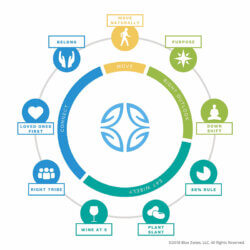September 30, 2025

How to Live a Longer, Healthier Life
Living longer, happier and healthier has been top of mind for both individuals and now governmental policy. Simultaneously, medical research focused on avoiding cognitive decline is maturing. One very effective and non-controversial pathway to a better society and healthier culture would be to encourage positive behaviors for everyone. Healthy, vigorous and mentally sharp people of all ages are more productive and consume fewer resources.
Governmental Policy
The Centers for Medicare and Medicaid Services (CMS) Administrator Dr. Mehmet Oz turned 65 recently and signed up for Medicare. He also started a podcast encouraging people to stay healthy and feel their best. The first episode began by encouraging folks to walk 30 minutes per day or “move naturally,” which is the top of the circle of nine healthy Blue Zones principles where more people live to 100. [1]
Subsequently, in a short video interview with National Desk, Dr. Oz encouraged purposeful activities for Medicaid beneficiaries who have the ability to contribute to society:
“… We have to do that by allowing folks who can work to get off the couch and do just that. The average able-bodied person on Medicaid who is not working spends over six hours watching television or just hanging out. So, we’re asking them to prove that they actually have agency over their future, that they want to make a difference for the world. Go out there for 20 hours a week, volunteer, get educated, get a job, do something that shows you are going to make the world a better place.” [2]
Having purpose is directly under the apex of moving naturally in the schematic representation of the nine healthy principles of Blue Zones. I’m hopeful Dr. Oz will continue with healthy eating, avoiding loneliness, engaging in family activities and participating in faith-based activities, all of which are proven to add years of healthy life.
International Medical Scientific Studies
Coinciding with Dr. Oz’s encouraging thoughts is the New England Journal of Medicine’s March 30 article, “Global Effects of Cardiovascular Risk Factors on Lifetime Estimates,” which demonstrated that five classic risk factors at 50 years of age were associated with more than a decade of greater life expectancy. Government urgings combined with objective medical research is a powerful combination to add years of healthy life expectancy. [3]
An international study including over 2 million people in 39 countries examined people who lived to 90. At age 50, those individuals who did not have hypertension, hyperlipidemia (high cholesterol or triglycerides), diabetes, did not smoke and had a normal weight had 13 years of additional healthy lifespan. Men who had all these deleterious characteristics died 10.6 years earlier and women 13.3 years sooner. Heart disease was the leading cause of death, followed with cancer as second and avoidable medical errors ranking third. [4]
Blood pressure control by age 55 had the biggest impact followed by smoking avoidance. Heart disease imposes substantial social, economic and public health burdens. Half of all cardiovascular disease could be controlled by effective risk management. The best way to add years of life expectancy is to stop people from starting to smoke. The next best way is to control blood pressure, which is generally easy to treat with medications and lifestyle modification.
Tobacco avoidance is very effective when started in young teenagers. Spending about $180 dollars on tobacco avoidance will save teenagers, their families and the country more than $53 billion by reducing smoking related costs. The benefit of misery avoidance for the up to 293,500 young people who would likely become established smokers and didn’t is incalculable. The misery of having cancer and/or being treated for lung disease, besides the other sequelae of tobacco, is much greater than the newly addicted smoker could possibly realize. [5]
The link between tobacco, lung cancer and other cancers was first published by Morton L. Levin, M.D., in 1955, but denied for decades by the tobacco industry. Dr. Levin’s findings were based on demographic surveys of patients admitted to Roswell Park Memorial Institute in Buffalo, New York, from 1938 to 1950. These findings were underappreciated by society and attacked by those whose incomes depended on tobacco profits. I worked under Dr. Levin as part of the National Science Foundation program during the summer of 1966 as a college student. I didn’t realize until later that Dr. Levin would have been considered for a Nobel Prize had times been different. [6] [7]
Avoiding Cognitive Decline
According to the website, the Alzheimer’s Association U.S. Study to Protect Brain Health through Lifestyle Intervention to Reduce Risk (U.S. POINTER) is a two-year trial to evaluate whether lifestyle interventions to target many risk factors protects cognitive decline. The good news is that a combination of diet, exercise, heart health, cognitive challenges and social engagement works in diverse populations for everyone across the nation. [8]
In 2014, a Finnish study showed similar effects of “physical exercise, a healthy diet, cognitive stimulation and self-monitoring of heart health risk factors [also] had a protective effect on cognitive function,” according to a report from the Alzheimer’s Association. The attributes differ slightly only in social engagement. Going forward the Finnish and American researchers will be focusing on the prevention of cognitive decline and other dementias across the globe.
“Structured vs. Self-Guided Multidomain Lifestyle Interventions for Global Cognitive Function,” published in the Journal of the American Medical Association in July showed that “a structured, high-intensity intervention had a statistically significant greater benefit on global cognition compared with an unstructured, self-guided intervention.” The participants were at higher than normal risk for cognitive decline because of a sedentary lifestyle, suboptimal diet, family history, cardiometabolic risk and age. [9]
Proven Behaviors to Add Years of Healthy Life
Although healthy eating always appropriately tops the list of important behaviors for living longer and better, never underestimate the importance of family, friends and belonging to a faith-based organization.
Multigenerational families do better with the seniors living longer, according to Columbia University’s Mailman School of Public Health. A systematic review of intergenerational coparenting confirmed improved child development outcomes. Enjoying emotional support, mental well-being and a sense of belonging are just a few other obvious benefits. The tangible economic benefits can also help in stressful times for families needing childcare and/or senior care. [10] [11]
Faith-based participation is associated with longer life expectancies, as documented in a Journal of the American Medical Association article. This article studied U.S. women from the renowned Nurses’ Health Study, which currently includes 280,000 individuals who complete yearly surveys that include questions about their participation in religious activities. The relationship between faith and longevity is well-documented, with studies showing that regular attendance at religious services can add 4 to 14 years of life expectancy. Faith-based communities encourage social interaction, volunteering and can be an antidote for loneliness. [12] [13] [14]
 Loneliness worsens health as was well known before the COVID epidemic, but was sadly exacerbated thereafter. “Friends Now More Than Ever: The Joy, Health and Power of Connection” makes the point that no matter our age, friendships are essential. Surgeon General Vivek Murthy issued an urgent advisory in 2023 describing loneliness as a “subjective distressing experience that results from perceived isolation or inadequate meaningful connections, where inadequate refers to the discrepancy or unmet need between an individual’s preferred and actual experience.” Interestingly, the overlap of loneliness and lack of purpose are almost identical when populations are studied. Namely, two of the Blue Zones principles, purpose and friends, come together as important attitudes for living longer, happier and healthier. [15] [16] [17] [18]
Loneliness worsens health as was well known before the COVID epidemic, but was sadly exacerbated thereafter. “Friends Now More Than Ever: The Joy, Health and Power of Connection” makes the point that no matter our age, friendships are essential. Surgeon General Vivek Murthy issued an urgent advisory in 2023 describing loneliness as a “subjective distressing experience that results from perceived isolation or inadequate meaningful connections, where inadequate refers to the discrepancy or unmet need between an individual’s preferred and actual experience.” Interestingly, the overlap of loneliness and lack of purpose are almost identical when populations are studied. Namely, two of the Blue Zones principles, purpose and friends, come together as important attitudes for living longer, happier and healthier. [15] [16] [17] [18]
Conclusion
Common sense principles, which have been carefully studied and documented, should be propagated for everyone’s good. Although it is not mandatory to accept or practice, people will learn from each other about the advantages, which will result in living a longer, happier and healthier life. And of course, the best way to stay healthy is to not get sick in the first place.
We should not focus on resistors to change, apropos of the quote attributed to Darwin, “It is not the strongest of the species that survives, nor the most intelligent, but the one most adaptable to change.” Much of the population will adapt, thus freeing up precious resources that previously were consumed by the 80% of self-induced illnesses.
Sources
- “Stay Healthy with Dr. Oz: Walking,” Dr. Oz, YouTube, July 2025.
- “Dr. Oz says able-bodied people have to ‘get off the couch’ for Medicaid,” Dr. Oz, YouTube, July 2025.
- “Global Effect of Cardiovascular Risk Factors on Lifetime Estimates,” The Global Cardiovascular Risk Consortium, March 30, 2025.
- “Medical Errors Kill. Being Transparent Will Save Lives,” Allen Weiss, 4sightHealth, February 18, 2025.
- “The Real Cost: A Cost-Effective Approach,” U.S. Food & Drug, August 20, 2019.
- “The Cigarette Smoker and Lung Cancer,” Morton L. Levin, CA: A Cancer Journal for Clinicians, March/April 1960.
- “Cancer and Tobacco Smoking,” Morton L. Levin, Hyman Goldstein and Paul Gerhardt, Journal of the American Medical Association, May 26, 1950.
- “A Lifestyle Intervention Trial to Support Brain Health and Improve Cognition,” Alzheimer’s Association, 2025.
- “Structured vs Self-Guided Multidomain Lifestyle Interventions for Global Cognitive Function,” Laura Baker, Mark Espeland, Rachel Whitmer, et. al., Journal of the American Medical Association, July 28, 2025.
- “Living with Parents or Grandparents Increases Social Capital and Survival: 2014 General Social Survey-National Death Index,” Peter Muennig, Doshen Jiao and Elizabeth Singer, November 10, 2017.
- “Intergenerational Coparenting and Child Development Outcomes: A Systematic Review,” Welman Xu, Gilbert Parra, Ma’Klya Carter, October 21, 2024.
- “Association of Religious Service Attendance With Mortality Among Woman,” Shanshan Li, Meir Stampfer, David Williams, et. al., JAMA Internal Medicine, June, 2016.
- “Nurses’ Health Study,” Harvard School of Public Health, August 11, 2025.
- “Attending Religious Services Linked to Longer Lives, Study Shows,” Harvard Health Publishing, July 14, 2016.
- “The public health impact of loneliness during the COVID-19 pandemic,” by James Allen, Oliver Darlington, Karen Hughes, Mark Bellis, BMC Public Health, August 31, 2022.
- “Friends Now More Than Ever: The Joy, Health and Power of Connection,” Allen Weiss, 4sightHealth, April 15, 2025.
- “What is Causing Our Epidemic of Loneliness and How Can We Fix It?” Elizabeth Ross, October 25, 2024.
- “Loneliness in America: Just the Tip of the Iceberg,” Milena Batanova, Richard Weissbourd and Joseph McIntye, Harvard Graduate School of Education, October 2024.





